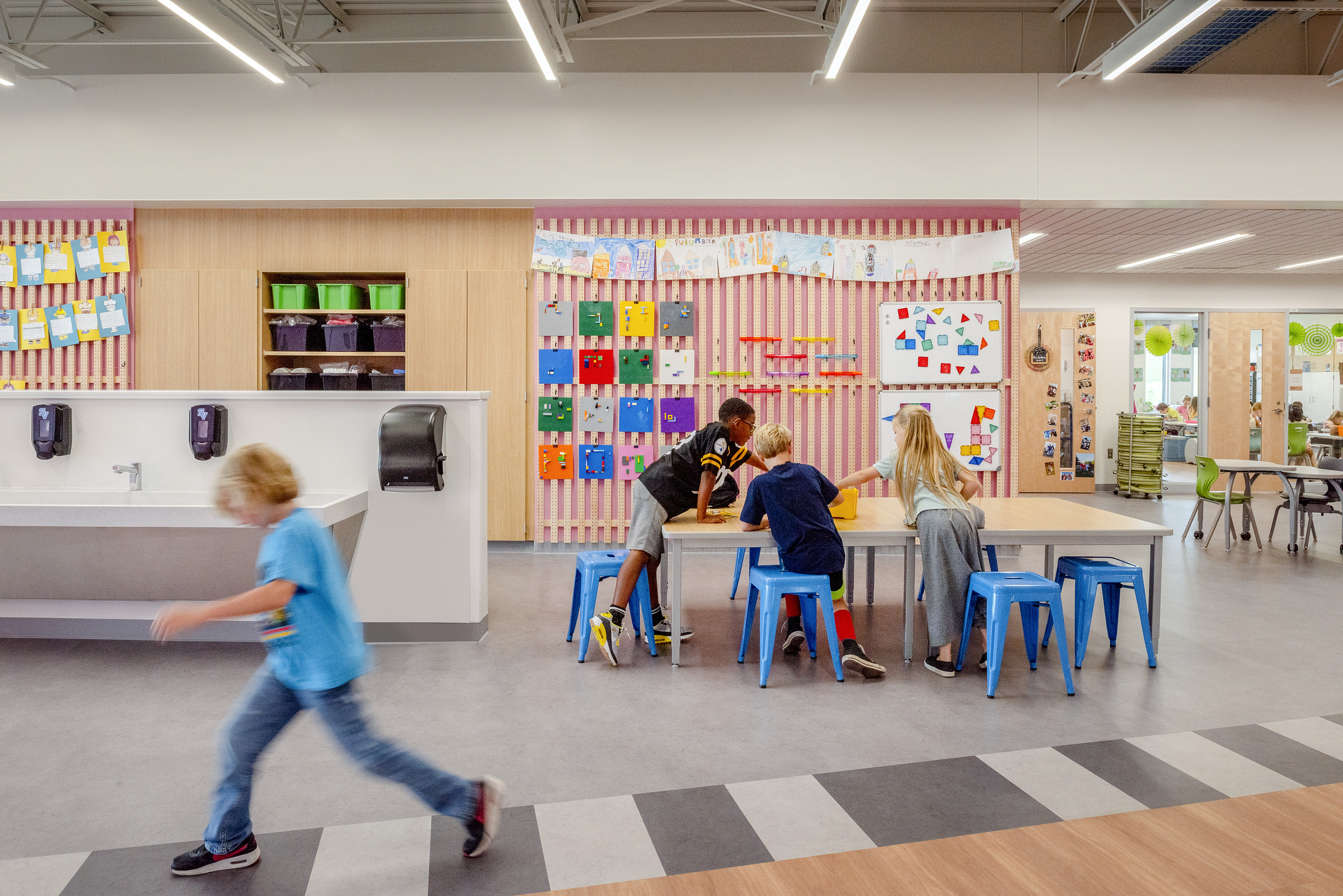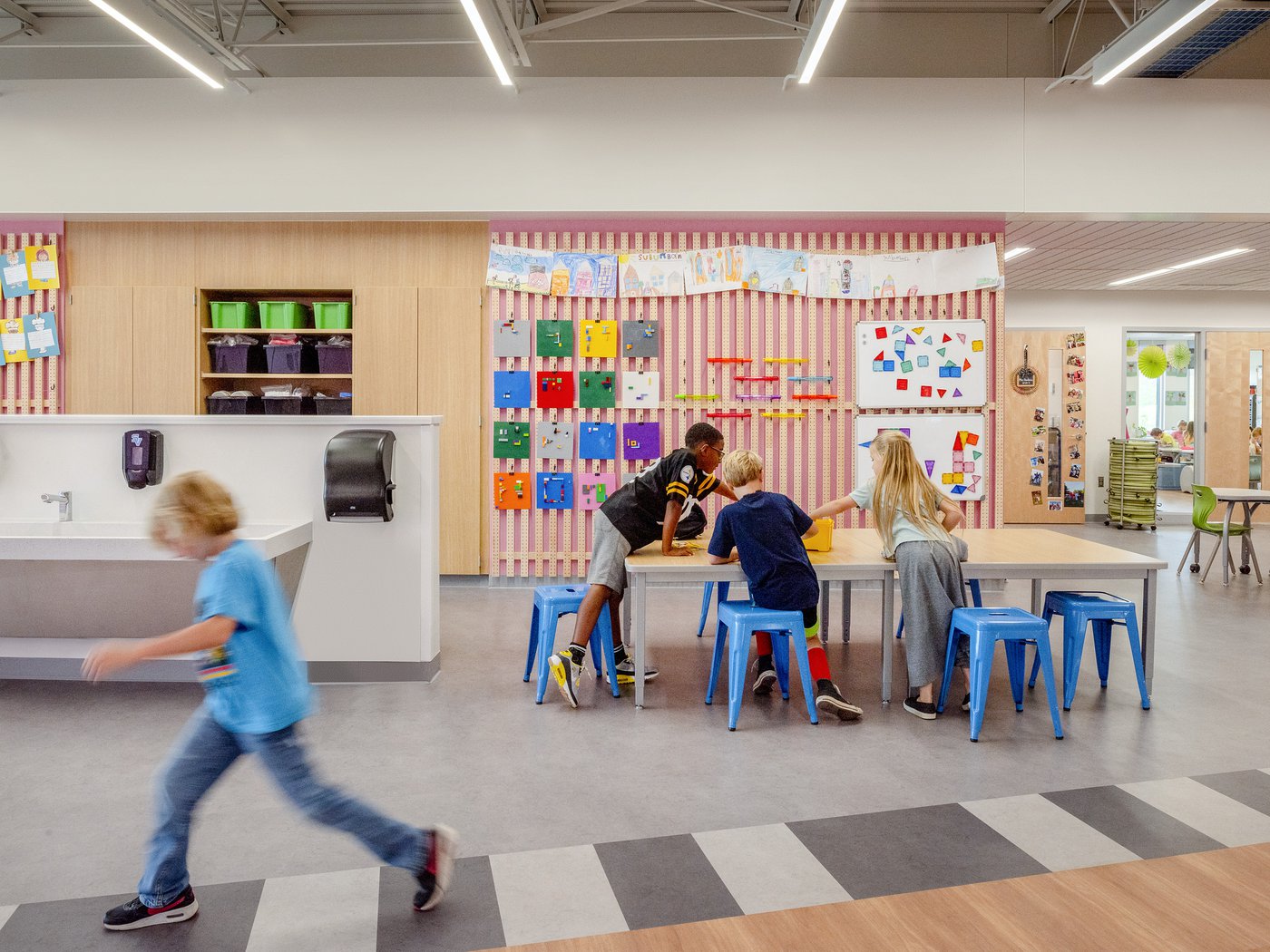It’s inevitable: Every year, kindergarteners arriving to school for the first time erupt into tears from the separation anxiety.
But at one new Pittsburgh-area school, it wasn’t nearly as scary for first-time students entering the building this year. Tracy Vitale, superintendent of the suburban Seneca Valley School District, only saw one crier, and the girl instantly cheered up when Vitale led her to the colorful, winding ramp that curls up the center of the school.
“She looked up at me and said, ‘I love this ramp!’” Vitale says. “That was the end of the crying.”
At Seneca Valley’s Ehrman Crest Elementary and Middle School, K-6 students are benefiting from an unusual collaboration. School leaders, architects and the Children’s Museum of Pittsburgh teamed up on the $63 million project, which opened in August 2022 after 790 construction days. With a student capacity of 1,400, the 200,000-square-foot facility takes a novel approach, forgoing the traditional school design for the playful, interactive, colorful elements of a children’s museum. Time magazine declared it one of the “Best Inventions of 2022.”
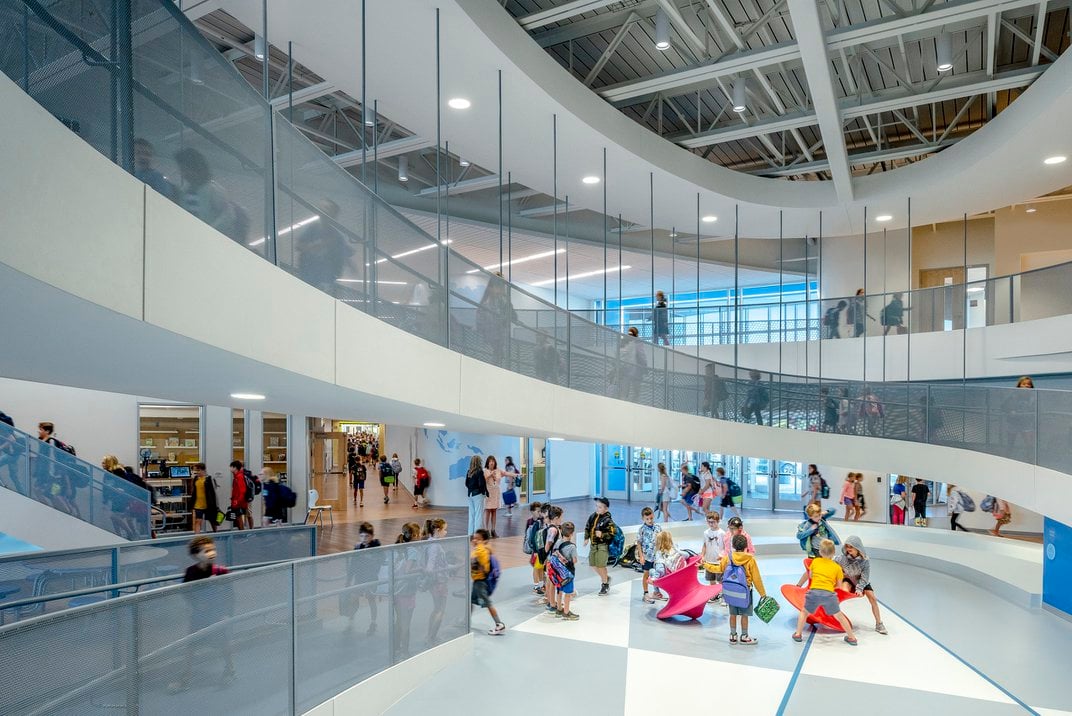
“Public schools and the Children’s Museum had the same goal, which was to educate children, but the way they were doing it and the paths they were taking were wildly different,” says Michael Corb, an architect with CannonDesign, the firm behind the project. He thought, “Why aren’t public schools going about it the way the Children’s Museum does?”
The Children’s Museum of Pittsburgh opened in 1983 on the city’s North Side and welcomes more than 300,000 visitors a year. It is known for its innovative, interactive and multilayered play features. Popular areas of the museum include the Makeshop, where kids create, play and design using processes like woodworking; Waterplay, where kids can get a little wet while doing activities involving rain, spray and ice; and the Limb Bender, a stacked maze where kids climb and crawl.
The history of children’s museums in the United States stretches back to 1899, when the Brooklyn Children’s Museum opened its doors. The next three earliest museums established for youngsters were the Boston Children’s Museum in 1913, the Detroit Children’s Museum in 1917 and the Children’s Museum of Indianapolis in 1925. All of these museums saw themselves as partners with public schools, because they fostered learning, according to the Association of Children’s Museums. Today, the U.S. has more than 300 children’s museums, which are known for hands-on and imaginative play elements.
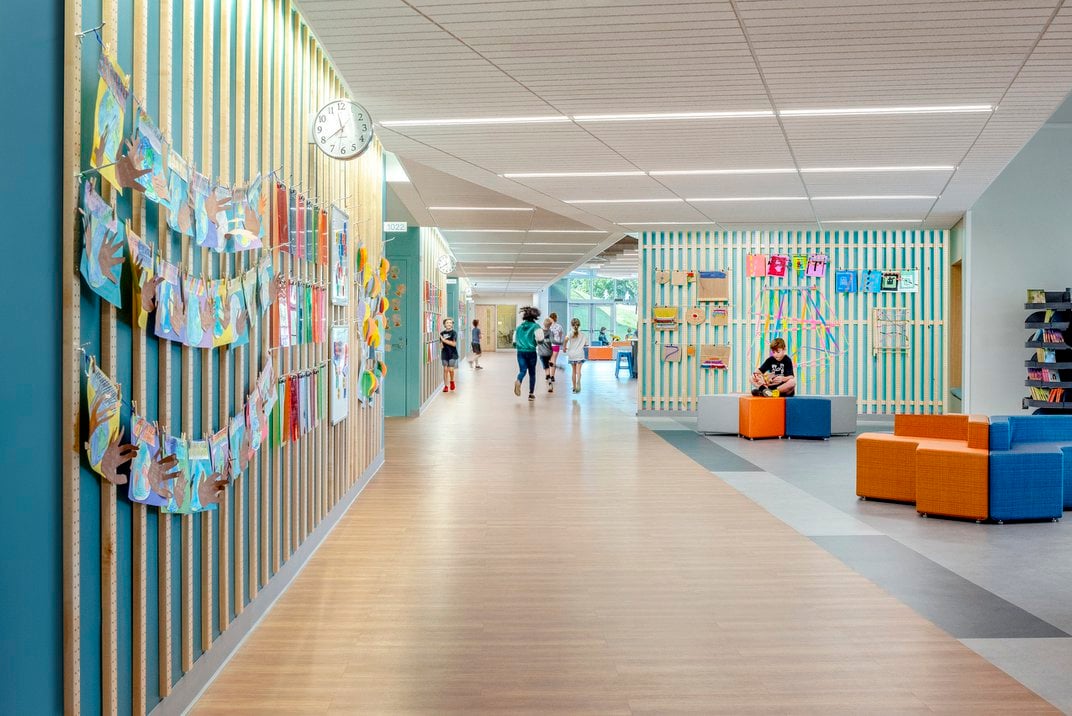
Merging the design philosophies of a children’s museum and a school creates an enriched learning environment, says Troy Hoggard, design principal for CannonDesign.
In a traditional elementary or middle school, the classroom alone is emphasized as the place for learning, while corridors are simply roads to move from one classroom to another. This mid-to-late-20th-century design came from an efficiency mindset in the postwar era, Hoggard says. It assumes that students learn much the same, and at a similar pace, using the same resources. But this doesn’t fit well with modern social and career expectations, he says.
You can see the Ehrman Crest difference starting with the front entrance, where kids can watch water dribble from a roof funnel down a rain chain. Signs at intriguing features like this one offer prompts rather than definitions, and they are meant to inspire students to work with their teachers and classmates to find answers to questions—in the case of the rain chain, why does the water flow the way it does?
Inside the main lobby, the giant, twisting ramp has magnetic walls that display colorful geometric shapes. From the landing at the top, you can peek through little windows into kindergarten areas that feature whimsical lights and soft benches in playful hues like lime green and navy blue. A glass wall overlooking the middle school cafeteria allows kindergarteners to see older students in action.

Outside of the kindergarten classrooms, kids can access roof gardens—where they grow plants like lettuce in the spring—and a “merry-go-pedal” playground structure with little bikes instead of horses. Students in all grade levels will participate in gardening at a few locations around campus.
In the school’s art wing, which is the designated emergency shelter if needed, projects are displayed on the wall at various stages of completion to show progress.
“We strive to teach the process of learning and not just focus on the end product; this promotes a growth mindset and learning from our mistakes,” says Lauri Pendred, principal of Ehrman Crest Elementary School. “This progress is certainly a part of the overall vision, which is that the school will be a sustainable, safe and dynamic context for learning that engages unique minds in diverse ways and is reflective of the community.”
Downstairs, on the first of the school’s two floors, kids in grades 3 to 5 grow lettuce in a portable hydroponic lab. They move magnets around on a giant wall map of Pennsylvania and the United States, to explore their location in the county, state and country in a tactile way. And near the front entrance, a big sundial lets students locate the sun’s position as light spills through the windows.
Ehrman Crest redefines the typology of a classroom, which sometimes has a sterile feel to it. “There are preconceived notions about what a school should be,” Hoggard says. “We’re finding that in many cases, old ideas about typology aren’t serving needs.”
Children have different needs and learning styles, and instead of trying to group different learning styles (say, readers versus visual learners) into corners of a traditional classroom, Ehrman Crest teachers can send several students with similar learning styles from different classes into nearby rooms quickly.

Colorful, quirky and comfy furniture is a hallmark of Ehrman Crest. No district-level choice of furniture was enforced; teachers got to choose the furnishings for their classrooms and personalize their surroundings. The classrooms feature movable partitions and furniture to emphasize student collaboration and hands-on learning. Desks are curved-edge tables that can move and be interconnected, and they double as whiteboards. The classroom design focuses on flexibility and how every space can link together for a collaborative and educational purpose, district officials say.
Unlike standard school classrooms, Ehrman Crest has no bulletin boards or chalkboards. Collaboration and small group spaces serve as an extension of the classroom, and teachers use pegboard systems for display.
The overall goal of Ehrman Crest is to make learning more engaging and interactive. All elements blend together smoothly and playfully, Vitale says.
“There’s this whole synergy of being in a building where the space is curated for learning and enhancing the learning,” the superintendent says.
Sean McCarty, Seneca Valley’s assistant superintendent for grades K-6, says the museum-like features of Ehrman Crest spark creativity in both children and teachers.
“Teachers now within seconds can change their entire learning environment because of the mobility of this furniture,” McCarty says. “Children seem more excited.”
Each grade-level wing has unique features, he says.
“The goal with this building is, every year, kids are going to be able to engage with something different or engage in something in a different way,” McCarty says.
Seneca Valley is hearing from school districts in Pennsylvania and other states that are interested in creating a similar type of school, he says.
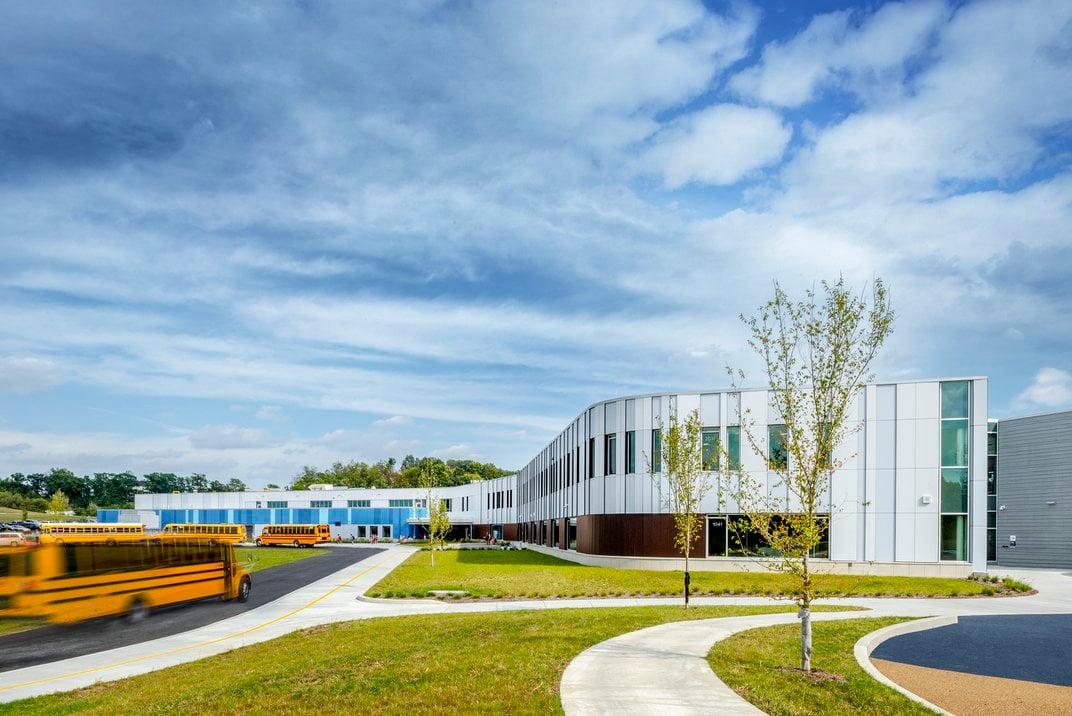
The first steps of the Ehrman Crest project began about two decades ago, when the district north of Pittsburgh conducted a feasibility study and considered which of its schools to renovate, Vitale says. Ehrman Crest replaced 84-year-old Evans City Elementary and Middle School, which was located at a separate site until its June 2022 closing.
District leaders wanted to rethink what a school building looks and feels like. “We agreed as a leadership team that we want school to be fun,” Vitale says.
Later, the CannonDesign architects suggested that district leaders reach out to the Children’s Museum of Pittsburgh for ideas. Museum professionals made recommendations on finishes, how to display student work, and the overall look and feel of the space and furniture. Architects, administrators and principals talked to kids to get their input. Many students said they wanted a variety of experiences on the playground, where they could both socialize and be challenged, says Tim Eiler, Ehrman Crest Middle School principal. As for the classroom environment, many students said they wanted to work with their peers, Eiler says, which inspired the collaboration spaces.
Anne Fullenkamp, the design director for the Children’s Museum of Pittsburgh, says schools often partner with museums on programs and educational initiatives. However, Ehrman Crest is the only one she knows of that built a new school with museum-inspired design.
“I think for some kids, it really creates some opportunities to learn in different ways,” Fullenkamp says. “It takes away some of the stigma or anxiety or stress about being in school. When they come to the children’s museum, all that goes away. We see some kids flourish.”
A report from the Children’s Museum Research Network says that play has become a low priority in and out of school settings, making it extra important for children’s museums to provide play-based experiences.
Hoping to buck this trend, Ehrman Crest has had a successful opening in part because the school community and administrators were both 100 percent on board with the whole idea, Fullenkamp says.
CannonDesign, known for its design projects in health care, education and museums, would love to work on another school, Corb says. It wouldn’t be a replica of this school—the first the firm ever designed in partnership with a children’s museum—because each school is designed with its own community in mind.
Matilda McQuaid, acting curatorial director at Cooper Hewitt, Smithsonian Design Museum in New York City, says this is the first time she has heard of a museum collaborating with a school to create a new environment from the ground up. This is interesting and new, she says, and seems to combine elements of Montessori teaching and Rudolf Steiner’s Waldorf education methods by allowing kids freedom to explore and experiment.
“In this environment, it’s somewhat similar in the sense of it’s making the learning process very experiential and learning by doing,” McQuaid says.
Building interactive, museum-influenced elementary schools may be a trend of the future, if it’s affordable, she says. The average cost of building a new American elementary or middle school varies widely, ranging from $230 to $539 per square foot in different parts of the country, according to Cumming Group, a construction cost consulting company. Existing schools also could be retrofitted with some of these museum-inspired elements, McQuaid says.
“Children love the sense of play that happens at a children’s museum, being able to go through an exhibit at your own speed, and the emphasis placed on hands-on learning or learning by doing,” McQuaid adds. “I think this kind of learning is especially important for those with learning disabilities or those who might respond better to visual props and interacting with them.”
Seneca Valley district officials say they plan to evaluate the efficacy of the new school’s design, take what they learn and use it in other building renovations to come.
With rooms and corridors full of mostly smiling kids, perhaps Ehrman Crest is the future of elementary and middle school education.
